This is a free fortnightly newsletter about the New Zealand Net.
If you would like to be notified by email when a new edition is published, please subscribe here.
Browse our Newsletter Archive and List of Net Tips.
Featured key
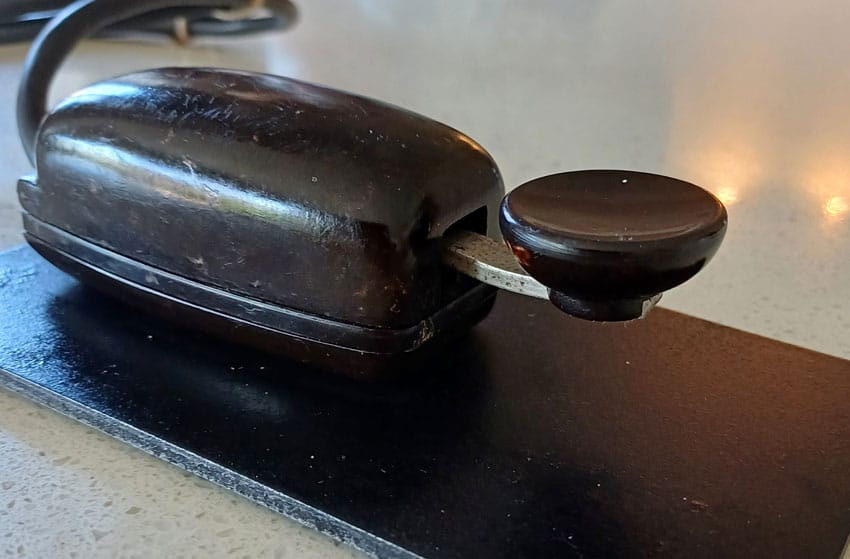
By Herman VK2IXV
This is a German Luftwaffe (Air Force) ‘Maus’ (‘Mouse’) training key. The key, with its original wire and plug, has a round concave Bakelite knob and a hinged dark brown Bakelite clamshell lid, which gives the key the appearance of a mouse. It is attached to a heavy 3mm steel baseplate with rounded corners, measuring 84 x 150mm, which is covered underneath with green felt.
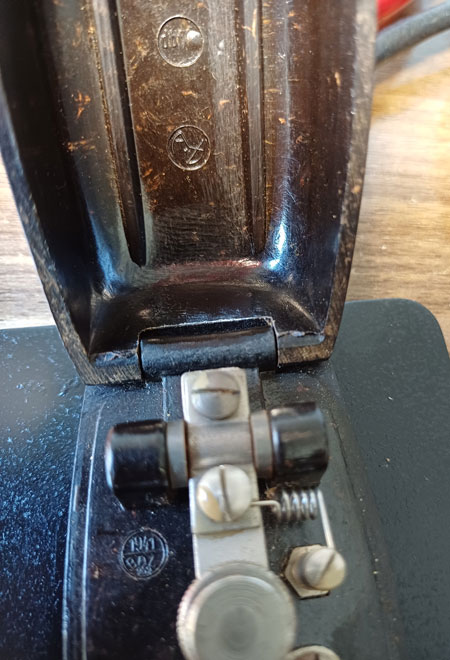 The markings on the key are TKP 1941 BAL 969, T1 and dbf.
The markings on the key are TKP 1941 BAL 969, T1 and dbf.
The meanings of the markings are as follows:
The jury is still out on what TKP exactly stands for, but a likely explanation is: “Taste Klein Pressstoff or Phenolharz” = “Key Small Bakelite”.
1941 is its year of manufacture.
BAL 969 = Bau Aufsicht, Leitung des Reichsluftfahrtministerium 969 = Construction Supervision, Management of the Reich’s (Empire’s) Ministry of Aviation 969.
T1 = Bakelite material filler code.
dbf = The Maker’s Code for Wilhelm Hoppmann & Hermann Mulsow, Elektronische Spezialfabrik in Hamburg.
This type of key remains very popular among collectors, not so much for its performance, but more for reasons of nostalgia, history, their shape and the beautiful Bakelite material.
* If you have an interesting key for this feature, please send a nice clear photo and a few words describing it.
Quick notes
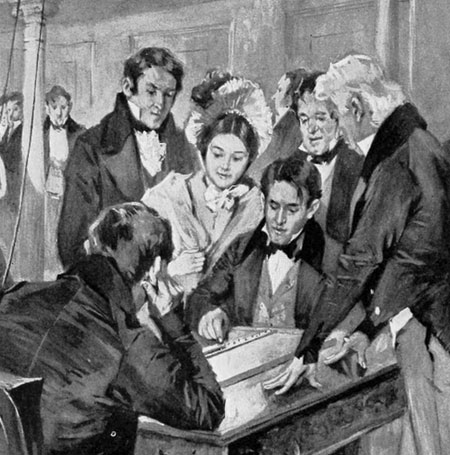 181 years ago: Samuel Morse sent the first official long-distance telegraph message, to open the Baltimore–Washington telegraph line, on 24 May 1844. Morse’s message (from Washington) to Alfred Vail (in Baltimore). was “What hath God wrought”, a phrase from the Bible’s Book of Numbers. The phrase was suggested by 17-year-old Annie Ellsworth, whose father was a supporter of Morse. Pictured: Samuel Morse sending the dispatch as dictated by Miss Ellsworth.
181 years ago: Samuel Morse sent the first official long-distance telegraph message, to open the Baltimore–Washington telegraph line, on 24 May 1844. Morse’s message (from Washington) to Alfred Vail (in Baltimore). was “What hath God wrought”, a phrase from the Bible’s Book of Numbers. The phrase was suggested by 17-year-old Annie Ellsworth, whose father was a supporter of Morse. Pictured: Samuel Morse sending the dispatch as dictated by Miss Ellsworth.
NZ Straight Key Night is two weeks away, on Sunday 8 June from 8 to 9pm NZT. Please pass the word to your CW friends. One of the highlights is the awarding of the Bruce Scahill Best Fist Award, as judged by SKN participants. See the video later in this newsletter for some advice on developing a really good fist!
The CQ WPX Contest is this weekend, so there should be lots of CW activity. If you’re not into contesting, or collecting new countries, then it’s a great opportunity to explore the WARC bands. 🙂
Graeme ZL2TE is enjoying his new house in New Plymouth. He is set up for 2 metres, and plans to erect an Inverted L for HF soon.
Photo flashback

Walvis Bay Radio ZSV in Namibia. The station callsign changed later to 5VW. Photo: Hein Bertram
Taming your bug’s dits
By Neil ZL1NZ
‘Scratchy dits’ caused by contact bounce are a common problem with some bug keys, even after cleaning the contacts. Careful adjustment of spacing and tension in the key may reduce the problem, but there are many cases where other ideas are needed.
One of the most popular approaches is the dot stabiliser, which pre-loads the dot contact spring. Such devices are not very hard to make, even if you don’t have a home machine shop. A few bugs, such as the Master Key featured in NZ Net News 149, even had dot stabilisers as part of their design.
Damping the dot spring with a piece of foam rubber is an even simpler approach that may help.
Some people say that a bit of capacitance across the contacts smooths out the dits.
The most sophisticated method of cleaning up dits involves building an electronic dit debouncer like this one, or this one.
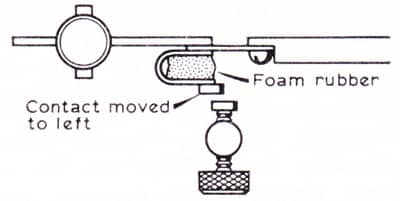 However, a technique I found in an old book is probably unbeatable in terms of simplicity:
However, a technique I found in an old book is probably unbeatable in terms of simplicity:
“With bug keys, contact bounce can often be prevented by adjusting the position of the moving dot contact so that only about one-quarter of the contact surfaces are in use, and by mounting a small block of foam rubber inside the dot contact U-spring.” (See diagram.)
– RSGB: Radio Communication Handbook, Fifth Edition, Volume 1 (1976)
Mugshot
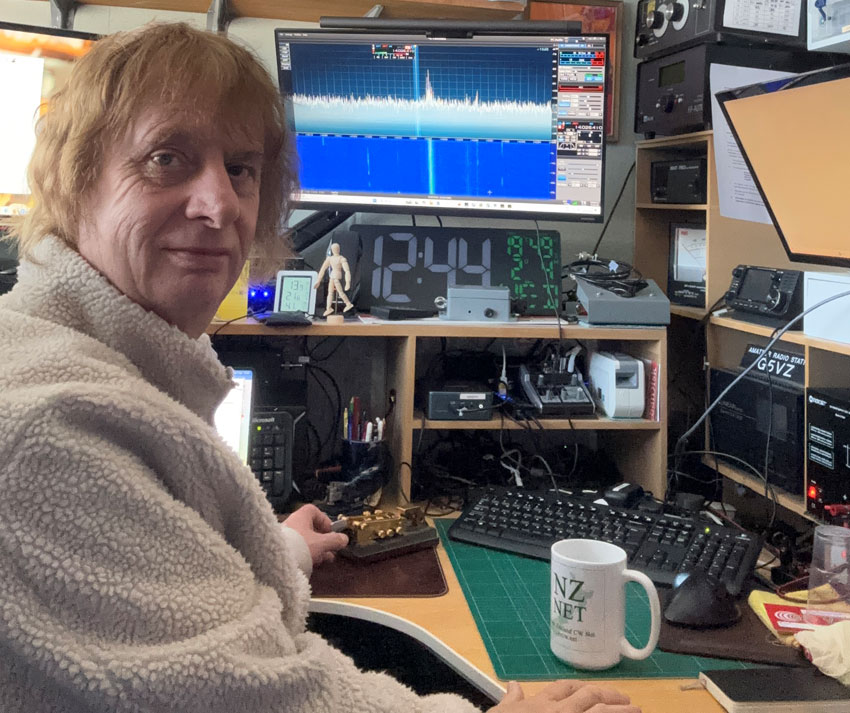
Chris G5VZ is such an enthusiastic supporter of NZ Net, he ordered two coffee mugs.
“I have adequate muggage now for myself – and a visitor,” says Chris.
“The key in the photo is my Begali Intrepid. Just behind it, and a little soft focus is a Begali Adventure on top of a uCPO that I use for side-tone with a Hermes Lite 2.
“I send left-handed although the Intrepid is the standard right-hand version. The paddles I use I keep dah-thumb, dit-finger.”
Poetry

The Railroad Telegrapher, Nov 1924
Video: Keymanship – part 1
Craig ZL3ADX drew my attention to a new series of videos which may help new, and not-so-new, CW operators improve their sending.
The videos were presented live, a few months ago, by Chris Rutkowski NW6V, who is well-known for his 2023 book The CW Way of Life.
My key take-away from the first video (below) is the concept of the dit-train, which is the underlying beat or rhythm of proper sending. In my opinion, most operators have no problem with the spacing of elements in a character (electronic keyers make this easy) but many ops lose that rhythm in their spacing between characters and between words. As Chris explains, every element we send should fit perfectly into a continuous dit-train.
The video is long, but I recommend it to anyone who wants to improve their sending, and regardless of the type of key they prefer.
Net tip: QNJ
We continue our look at Q signals with a very useful one: QNJ (callsign)?.
It can be used by anyone on the net.
When sent as simply QNJ? it means: “Can you copy me?”
The reply could be a signal report, or QNP if no copy (assuming the station heard the question). 🙂
More often, you will hear Net Control use it when they are pairing up two stations under marginal conditions to exchange traffic.
As an example, suppose NCS wants VK3DRQ to send traffic to ZL1PX. Assuming NCS can work both stations, they might send:
ZL1PX QNJ VK3DRQ? (Can you copy VK3DRQ?)
If affirmative, NCS would follow it up with:
VK3DRQ QNJ ZL1PX? (Can you copy ZL1PX?)
If affirmative, the stations can be sent off frequency for traffic. If not, then NCS will ask for another station to act as relay.
The A-Z of Q Signals

A well-run CW net is a lovely thing to experience. Communication between stations is quick and concise, and the net business is conducted with minimal time wasted.
As CW operators, we have many techniques to communicate quickly and efficiently. And if we know and use these techniques, we can often match or exceed the speed and accuracy of voice communication.
One of our most important tools is the set of Q Signals (or Q Codes), and in this series we look at the “essential” ones, in alphabetical order.
Advertising archive

Hallicrafters always made great-looking gear, and the SX-122 general-coverage receiver, introduced in 1962, was one of the prettiest, in my opinion.
It was superseded by the virtually identical SX-122A, featured in this advertisement, around 1964, and production continued until about 1968.
Both receivers had four bands to cover the full short-wave spectrum, dual conversion, eleven valves and a crystal filter.
Suggestions?
If you have suggestions on how to make the NZ Net better, or things you’d like to see covered in these newsletters, please contact ZL1NZ. Articles and photos will be gratefully received!
Thanks for reading, and I hope to hear you soon on the NZ Net!
—
Neil Sanderson ZL1NZ, Net Manager
New Zealand Net (NZ NET)


